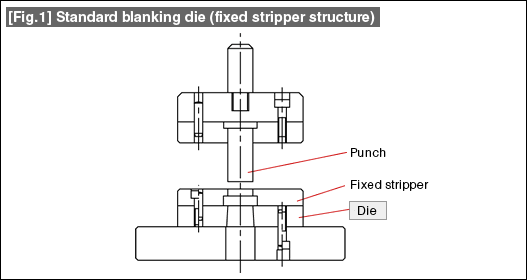#137 Design of Blanking Dies (10) Design of a Blanking Die
Figure 1 shows the structure of a standard blanking die. A die is a very important part that creates the shape of the product. The die hole machined in the die (die plate) is prepared with the shape of the product. In the case of a blanking die, the shape obtained after the material passes through the die hole becomes the product.

|
Coming back to the main topic, when determining the dimensions of the die, it is necessary to consider the blanking clearance. SeeLesson No. 5in which this blanking clearance has been explained.
In a blanking operation, a sideward force acts during blanking. The die plate breaks (cracks) if the distance from the circumference of the die to the outer periphery of the plate becomes small. Fig. 2 gives a guideline for the distance from the circumference of the die to the periphery of the plate.

While the above applies to the planar shape, it is also necessary to consider the cross-sectional shape (the shape as viewed from the thickness direction of the die plate. When the material is passing inside the die, it is good if it does not scrape against the inner surface of the die for too long. As an example, the cross-section of a die becomes as shown in Fig. 3. It is better that about three or four products stay inside the part of the die indicated as "s" and any additional products fall down.

There are several types in the method of preparing the cross-sections of such dies. This has been explained in detail in Lesson No. 6 about the shape of blanking dies.
- #167 Problems in Punching and their Countermeasures (6) Scrap Processing in Punching
- #166 Problems in Punching and their Countermeasures (5) Trimming of Drawn and Shaped Parts
- #165 Problems in Punching and their Countermeasures (4) Scrap Clogging in Punching
- #164 Problems in Punching and their Countermeasures (3) Bending and Twisting of Narrow Punched Parts
- #163 Problems in Punching and their Countermeasures (2) Bending due to Punching



